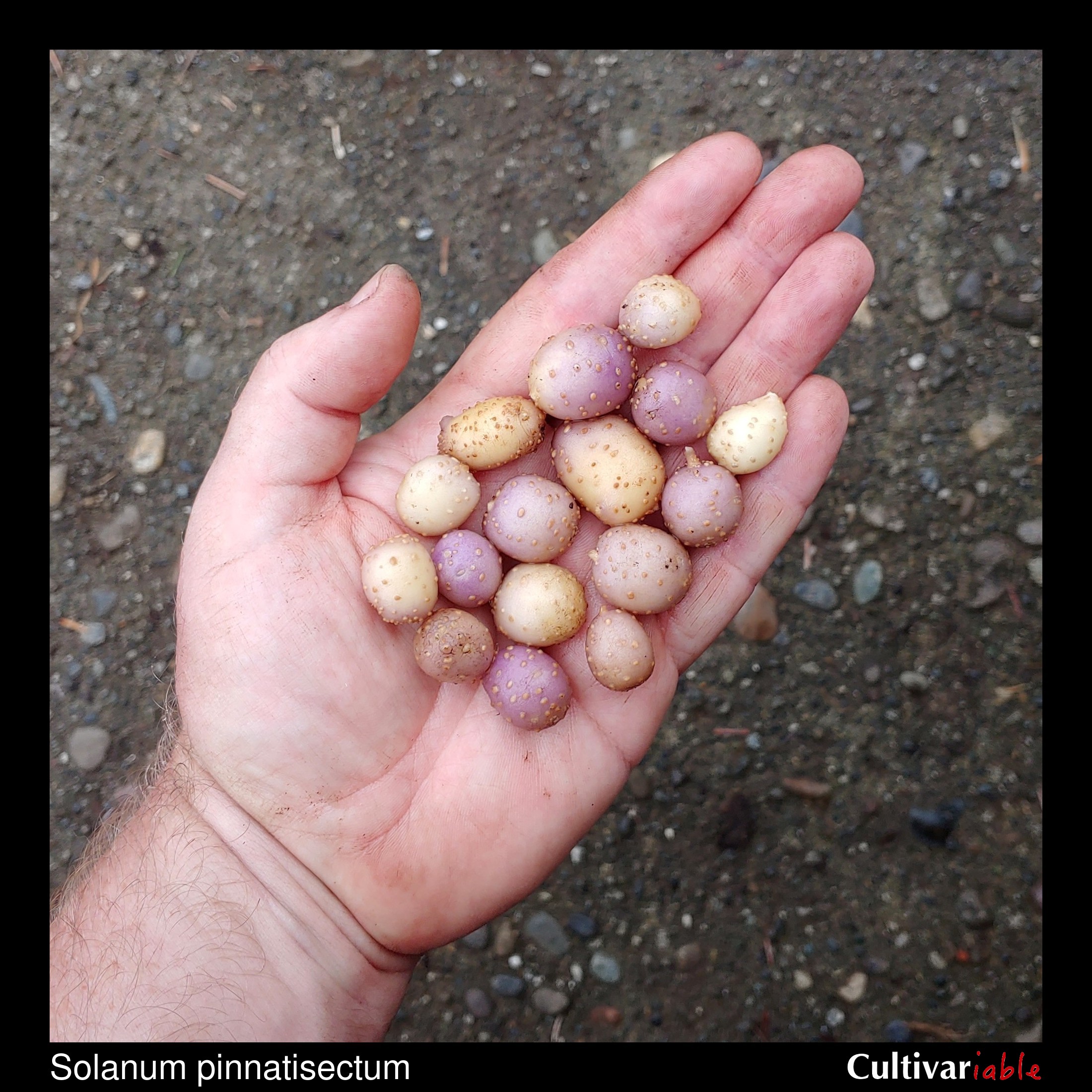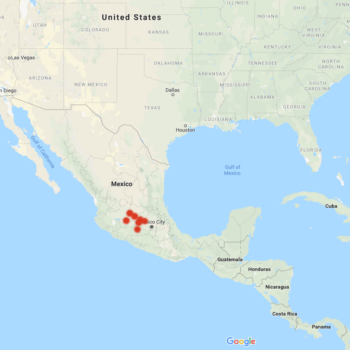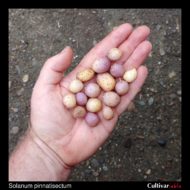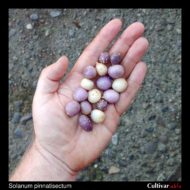Solanum pinnatisectum

| Common Names | |
| Code | pnt |
| Synonyms | |
| Clade | 1 |
| Series | Pinnatisecta |
| Ploidy | Diploid (2x) |
| EBN | 1 |
| Tuberization Photoperiod | Unknown |
| Self-compatibility | Unknown |
| Nuclear Genome | B |
| Cytoplasmic Genome | W |
| Citation | Dunal: Prodr. 13(1): 40. 1852. |
Description
 Solanum pinnatisectum is a dryland species from central Mexico with long, thin leaves. This sort of development occurs also in South American species growing under similar conditions, such as S. peloquinianum. It is interesting to observe how widely separate plants adapt to conditions in a similar fashion.
Solanum pinnatisectum is a dryland species from central Mexico with long, thin leaves. This sort of development occurs also in South American species growing under similar conditions, such as S. peloquinianum. It is interesting to observe how widely separate plants adapt to conditions in a similar fashion.
The specific epithet, pinnatisectum, refers to a leaflet arrangement that is similar to feathers. It is formed from the Latin words “pinnatus,” for “feathered,” and “sectum,” for “cut.” While there is no completely standardized pronunciation for scientific names, the most common way to pronounce this species is probably so-LAY-num pin-at-ih-SEK-tum.
Plants about 15 to 24 inches tall. Unusual berries with dark green stripes and lots of white speckles.
Hale (2008) found that S. pinnatisectum had very high antioxidant activity.
Resistances
This species can survive frosts down to 27 degrees F (-3 C) (Li 1977). Vega (1995) found that this species is about as frost tolerant as domesticated potato.
Bethke (2017) scored wild potato species as a composite of seven resistance studies and S. pinnatisectum ranked in third place.
Some accessions of this species carry the Rpi1, Rpi2, and Rpi-blb3 genes, which confer late blight resistance.
| Condition | Type | Level of Resistance | Source |
|---|---|---|---|
| Alternaria solani (Early Blight) | Fungus | Somewhat resistant | Jansky 2008 |
| Drought | Abiotic | Somewhat resistant | Machida-Hirano 2015 |
| Globodera pallida (Pale Cyst Nematode) | Invertebrate | Not resistant | Castelli 2003 |
| Globodera pallida (Pale Cyst Nematode) | Invertebrate | Not resistant | Bachmann-Pfabe 2019 |
| Globodera rostochiensis (Potato Cyst/Golden Nematode) | Invertebrate | Not resistant | Castelli 2003 |
| Heat | Abiotic | Somewhat resistant | Machida-Hirano 2015 |
| Leptinotarsa decemlineata (Colorado Potato Beetle) | Invertebrate | Somewhat resistant | Machida-Hirano 2015 |
| Meloidogyne spp. (Root Knot Nematode) | Invertebrate | Somewhat resistant | Machida-Hirano 2015 |
| Pectobacterium carotovorum (Blackleg/Soft Rot) | Bacteria | Somewhat resistant | Chung 2011, Machida-Hirano 2015 |
| Phytophthora infestans (Late Blight) | Fungus | Resistant | Machida-Hirano 2015 |
| Phytophthora infestans (Late Blight) | Fungus | Resistant | Bachmann-Pfabe 2019 |
| Potato Virus Y (PVY) | Virus | Somewhat resistant | Cai 2011, Machida-Hirano 2015 |
| Ralstonia solanacearum (Bacterial Wilt) | Bacteria | Somewhat resistant | Machida-Hirano 2015 |
| Synchytrium endobioticum (Wart) | Fungus | Somewhat resistant | Machida-Hirano 2015 |
Glykoalkaloid content
Images
 |
 |
||
Cultivation
I initially found this species difficult to germinate, but it turned out to just be an accession with unusually low germination. Other accessions have germinated easily using standard conditions. The USDA potato genebank has observed that germination of some accessions of this species is inhibited by GA3 (Bamberg 1999). In the wild. plants flower and fruit from July to September (Spooner 2004).
Towill (1983) found that seeds of this species stored at 1 to 3 degrees C germinated at 100% after 20 years.
Trapero-Mozos (2018) determined that this species will tolerate a temperature of 40 C even without prior acclimatization to warm temperatures.
Breeding
Crosses with S. tuberosum
| Female | Male | Berry Set |
Seed Set | Ploidy | Germ | Source |
|---|---|---|---|---|---|---|
| S. tuberosum | S. pinnatisectum | None | None | Jackson (1999) | ||
| S. pinnatisectum | S. tuberosum | None | None | Jackson (1999) |
Crosses with other species
Watanabe (1991) found that 14.8% of varieties of this species produced 2n pollen and Jackson (1999) found 3-13%, which would be effectively tetraploid and 2EBN.
| Female | Male | Berry Set |
Seed Set | Ploidy | Germ | Source |
|---|---|---|---|---|---|---|
